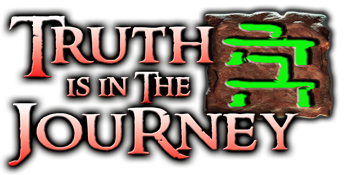BEE HIVE TEMPERATURE CONTROL
Temperature control in a bee hive is amazing. The bees have air conditioned hives! They keep the hive at a constant 95°F [35°C]. When the weather is cold, the bees congregate at the center of the hive and generate extra heat by increasing their metabolism. How they do that? By breathing faster!
Other bees collect all over the outer walls ¬and provide insulation to the hive! If the weather remains cool, the bees in the center rotate with the bees on the walls.When the weather becomes too warm, some of the bees go to the entrance and begin rapidly fanning their wings.
This brings in cooler air from the outside into the hive. If the weather becomes still warmer, other bees fly out of the hive and bring back water and wet the inside of the outer walls of the hive! At that point, the fanning of the other bees rapidly cools the walls as the water evaporates.What bee is smart enough to figure out all that? It couldn`t have without a Creator!

Dragons aka Dinosaurs at War with Elephants?
Non-believers think that dinosaurs and modern man were separated by millions of years of evolution, however, dragon like creatures are mentioned through all of history, even in the Middle Ages. The word dinosaur was not even invented until the 1800s, before then, they were what people called dragons. The definition OF a dragon in the 1700s was a "now rarely seen animal". Pliny the Elder even wrote of very detailed accounts of dragons wrestling with and attacking elephants. What other animal was large enough and brave enough to do this?
Pliny the Elder described elephants and dragons in the 1st century AD in his Natural History:
“India that produces the largest elephant, as well as the dragon, which is perpetually at war with the elephant, and is itself of so enormous a size, as easily to envelope the elephants with its folds, and encircle them in its coils. The contest is equally fatal to both; the elephant, vanquished, falls to the earth, and by its weight, crushes the dragon which is entwined around it.”
“The dragon has much difficulty in climbing up to so great a height, and therefore, watching the road, which bears marks of the footsteps (of elephants) when going to feed, it darts down upon them from a lofty tree. The elephant knows that it is quite unable to struggle against the folds of the serpent, and so seeks for trees or rocks against which to rub itself. The dragon is on its guard against this, and tries to prevent it, by first of all confining the legs of the elephant with the folds of its tail; while the elephant, on the other hand, endeavors to disengage itself with its trunk. The dragon, however, thrusts its head into its nostrils, and thus, at the same moment, stops the breath and wounds the most tender parts. When it is met unexpectedly, the dragon raises itself up, faces its opponent, and flies more especially at the eyes; this is the reason why elephants are so often found blind, and worn to a skeleton with hunger and misery. What other cause can one assign for such mighty strifes as these, except that Nature is desirous, as it were, to make an exhibition for herself, in pitting such opponents against each other?”
There is another story, too, told in relation to these combats —the blood of the elephant, it is said, is remarkably cold; for which reason, in the parching heats of summer,1 it is sought by the dragon with remarkable avidity. It lies, therefore, coiled up and concealed in the rivers, in wait for the elephants, when they come to drink; upon which it darts out, fastens itself around the trunk, and then fixes its teeth behind the ear, that being the only place which the elephant cannot protect with the trunk. The dragons, it is said, are of such vast size, that they can swallow the whole of the blood; consequently, the elephant, being thus drained of its blood, falls to the earth exhausted; while the dragon, intoxicated with the draught, is crushed beneath it, and so shares its fate.”

The Babylonian Exile: Ancient Tablets Reveal Jewish Life in Exile
Ever wondered what life was like for people forced to leave their homes due to war? Let`s talk about the Babylonian Exile of the Jews (around 600-530 BC) and some cool recent discoveries!
The Invasion:
- 605-586 BC: Babylon's King Nebuchadnezzar invades Judah
- Jerusalem destroyed, including the First Temple
- Thousands of Jews forced to move to Babylon
Prophet Jeremiah's Message:
- Bad news: Exile will last 70 years
- Good news: Jews will return home after that
- Advice: Build houses, plant gardens, have families in Babylon
The Al-Yahudu Tablets:
- Over 100 clay tablets discovered in Iraq in 2014
- Date from 572 to 477 BC
- Record everyday life of Jewish exiles
Life in "Judah-town":
- Jews lived in a village called Al-Yahudu ("Judah-town")
They could:
- Rent land for farming
- Buy and sell animals
- Pay taxes
- Get married and have families
- Relatively free life, as long as they followed Babylonian rules
Why This Matters:
- Confirms what the Bible says about this time
- Shows how people adapt to tough situations
- Proves it's possible to keep your culture alive far from home
Cool Fact: One tablet has Hebrew writing on it! This shows Jews kept their language alive in exile.
These clay tablets are like text messages from 2,500 years ago! They show us that history isn`t just about big events and famous people. It`s also about everyday folks living their lives, even in tough times.
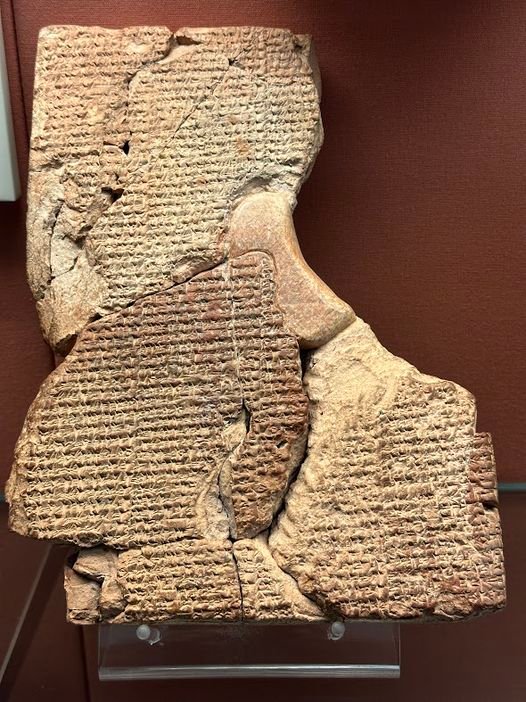
PIRI REIS AND ORONTEUS FINAEUS MAPS OF ICE FREE ANTARCTICA?
Two antique maps, that of Piri Reis map and Oronteus Finaeus map (circa 1500 AD), weirdly show Antarctica ice free. But this was a time when Antarctica had not even been discovered! Even more curious, Turkish Admiral Piri Reis’s map, was apparently sourced from the Pharaohs libraries in Alexandria 2000 years ago.
Investigating cartographers from the U.S air force were puzzled. The map portrayed the Antarctic coastline free of the three kilometre deep ice sheets. These buried coastlines were only recently outlined by the British polar expeditions. Even ice sheet buried rivers and mountains were shown.
The Oronteus Finnaeus maps were even more comprehensive and show the whole of Antarctica ice free!
According to believers in an Antarctic ice sheet millions of years old, this certainly wouldn`t seem possible. And without millions of years of slow gradual change, naturalistic evolution which requires this time, can`t occur. Not that it wasn`t already impossible to begin with...
Recently, we made a post about ancient artifacts found deep under Antarctic ice where they shouldn`t belong if it took ice millions of years to accumulate here. It would make sense that there was a time when man explored long before it was believed he was able to, and observed an ice free Antarctica.
In Greenland 1992, a World War 2 plane was found under 250 feet of ice. This accumulation would have taken thousands of years according to secular science. But it had just been 50 years prior!
What does all this tell us? It does NOT take millions of years for ice to accumulate. The current rate that is observable lines up with the idea the earth is much younger. 6,000 years is the correct age of the earth according to the Bible and its historical timeline.
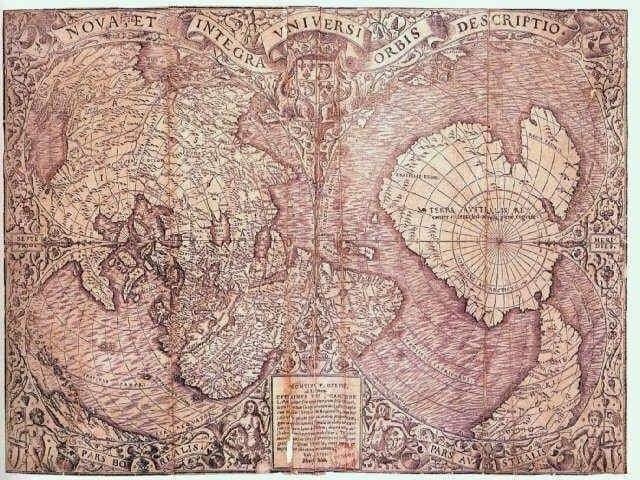
Man and dinosaurs..lived at the same time!
Figure 1. 1800s Paleontologist reconstruction of what they believed long necked sauropod dinosaurs looked like. Since they had never seen living dinosaurs, they were just giving their best guess. Obviously, they believed them to be more serpent like.
Figure 2 and 3 are actual carvings and anatomically correct visualizations from early Mesopotamia and a carving from a tomb in England. It appears a logical conclusion that ancient man saw living dinosaurs. How else could they have gotten it right before our modern scientists did? God created all dinosaurs along with man at the beginning of creation! They weren`t separated by nonsense evolution!
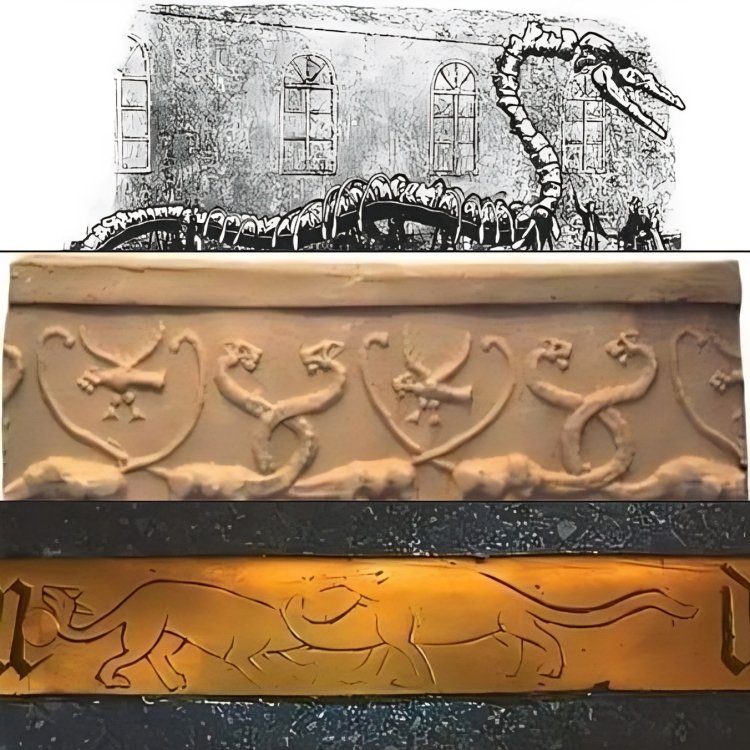
1000 cells fit on the end of a needle
1000 cells fit on the end of a needle. To stay alive, each cell needs to make over 700 million energy molecules a minute by spinning tens of thousands of molecular motors over 150 times a SECOND. No wonder Isaac Newton said that if someone really thinks, he has to believe in God! The God who made us with all this complexity loves us and wants us to live this life with Him while He is for us and helps us every day we live.
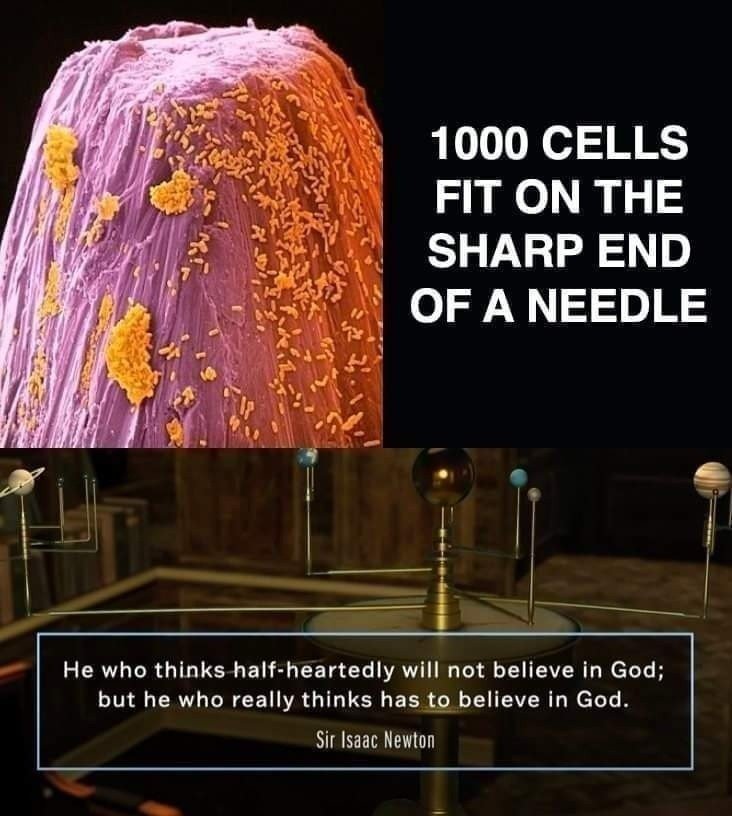
FOSSILIZED DINOSAUR EMBRYOS ARE FOUND ALL OVER THE WORLD
The only way this is even possible, is if the oxygen was cut off from the outside, allowing the embryo and the shell to fossilize. It had to be buried quickly. Global dinosaur fossils and global dinosaur eggs means we had a major flood sometime in the Earth`s past. The Bible mentions it as Noah`s flood! The evidence is overwhelming.
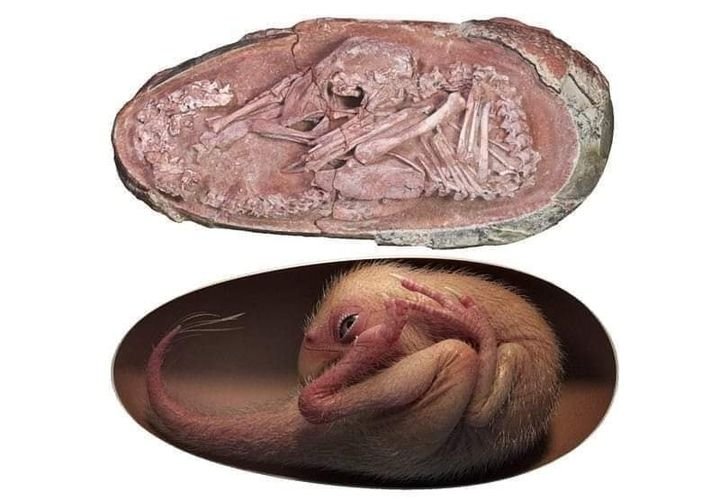
DNA FROM DUCKBILL DINOSAUR DISCOVERED!
A recent study of baby dinosaur skulls discovered in the 1980s has revealed actual dinosaur DNA!
How can this be possible if dinosaurs lived “millions” of years ago? 75 million according to evolution believing scienists. We know as Biblical Creationists, God made everything just 6,000 years ago, including dinosaurs. One paper was quoted as saying “DNA should be totally fragmented in about 6.8 million years”
This is basically in the realm of impossible. Most dinosaurs perished in Noah’s flood just 4,500 years ago, while some were taken on the ark as juveniles/babies, and lived on for a time until man hunted the smaller ones to extinction. Most if not all were probably smaller kinds to begin with.
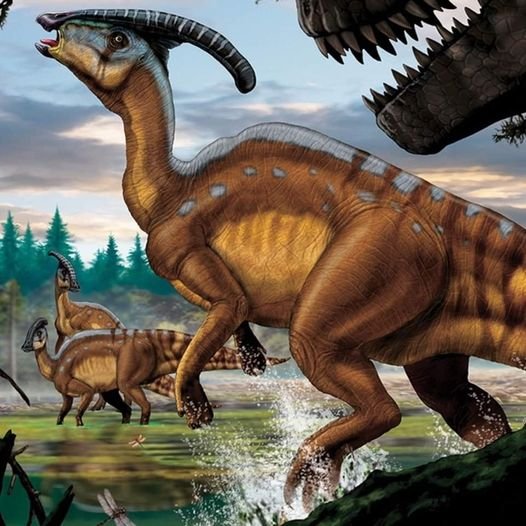
THERE IS JUST 5,000 YEARS OF HISTORY...
According to evolutionists, Stone Age Homo sapiens existed for 190,000 years before beginning to make written records about 4,000 to 5,000 years ago. Prehistoric man built megalithic monuments, made beautiful cave paintings, and kept records of lunar phases. Why would he wait two thousand centuries before using the same skills to record history? The Biblical time scale is much more likely.
It is also worth noting that at the same time writing appeared, there were 5 major groups that appeared almost out of nowhere with fully sophisticated architecture, writing, and intelligence, that even rivals our own today! Right within the Biblical timeframe, validating the flood event, and Babel thereafter.
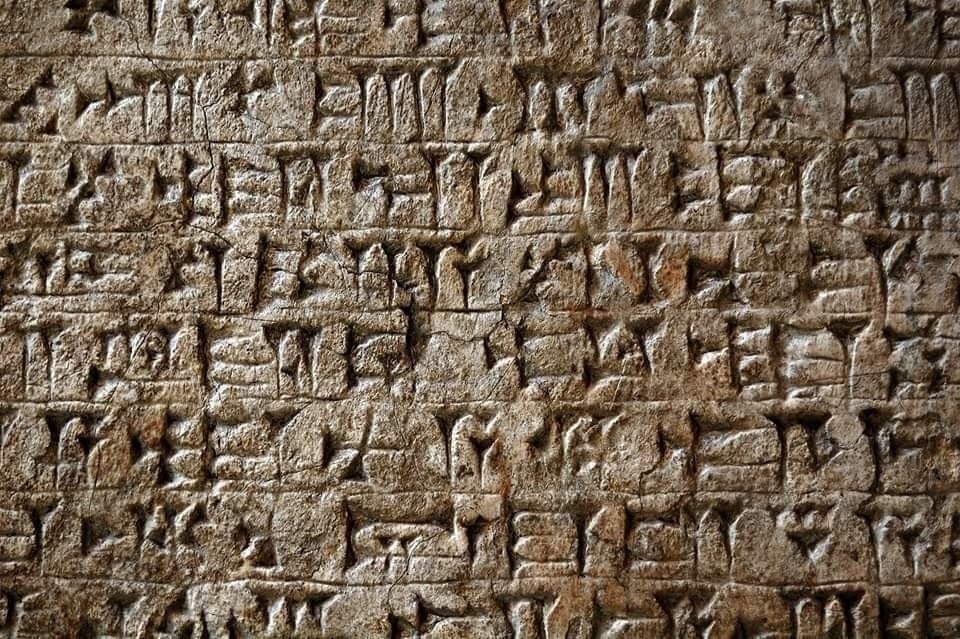
REAL PERSON'S BLOOD VESSELS
This is a real person's blood vessels. Very detailed and intricate. And still they say that we had no Designer.

AMAZING DESIGN
The scientific study of complex biological structures has made enormous strides in revealing Intelligent design in nature. One example is the motor and propeller propulsion system, called a bacterial flagellum, found in many bacteria, including the common E. coli. The propulsion system of the bacteria has 40 moving parts made from protein molecules, including a motor, rotor, stator, drive shaft, bushings, universal joint, and flexible propeller. The motor is powered by ions and can rotate at up to 100,000 rpm. It can reverse direction in only 1/4 of a revolution and has an automatic feedback control mechanism. The size is 1/100,000 of an inch (1/4,000 mm) in width, much too small to see with the human eye. One cannot deny the obvious conclusion that this system has an Intelligent Designer!
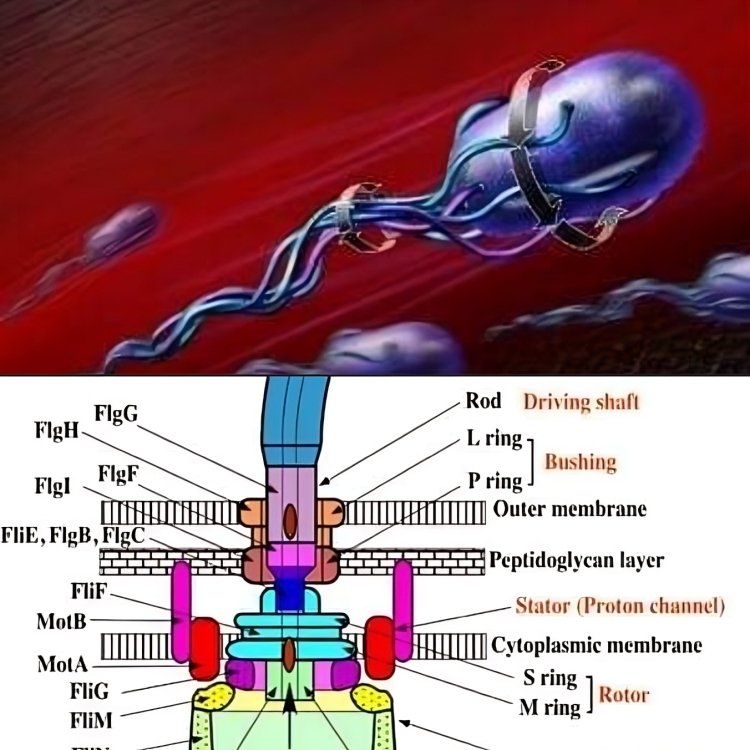
Proof of the Biblical Exodus account. The poisonous quail.
GOD took care of the Israelites, giving them manna and quail on their way to the promised land while roaming the desert wilderness. However, some food is not good for consumption. I see a supernatural phenomenon here, where GOD had to keep the quail from making the Israelites sick. We do have evidence that the quail they likely consumed could very well have done this.
Numbers 11:31-35
A wind from the Lord brought quail from the sea and let them fall around the camp. The quail were so plentiful that people could capture about ten homers, or eight bushels. However, many Israelites became sick and died after eating the quail as punishment for complaining about only having manna to eat. They were simply not thankful for what God had provided.
The quail that the Israelites ate were likely the Pharoah quail (coturnix coturnix). European quail are known to be poisonous and can cause a serious illness called coturnism if eaten.
Quail are only poisonous during their autumn migration from north to south, when they consume poisonous plants like hemlock seeds. Symptoms of coturnism include muscle tenderness, extremity pain, nausea, and vomiting. In severe cases, it can lead to paralysis, kidney failure, and cardiac arrest.
There are graves in the area, and it has been documented:
- In 1761, Barthold Niebuhr, a German explorer, found a huge cemetery with tombs and a sepulcher atop an inaccessible mountain called Sarbut-el-Khaden. Inscriptions were found on the tombs here (Voyage en Arabie, tom. i. p. 191).
- Niebuhr offered his doubts that the inscriptions were made by Egyptians as no carved inscriptions were ever found in Egypt; rather, they were partial to painting images on plaster. He also found legible inscriptions not only on the tombs but also within a small temple carved out of rock, all found to be of the same written language as the Hebrew Exodus inscriptions found at this same location.
- In addition to all of this, Niebuhr found numerous engravings of quails on the tombstones "standing, flying and apparently, even trussed and cooked" and noted that the Bedouins refer to this graveyard as the "Turbet es Yahoud" (grave of the Jews)
When another author, Dr. Stewart later explored this huge graveyard. He made molds of the inscriptions there, which were later translated by Rev. Charles Forster to appear in his 1962 book Sinai Photographed (p. 84):
- The apostates smitten with disease by God, by means of feathered fowls.
- Smitten by God with disease in the sandy plain, (when) exceeding the bounds of moderation.
- Sickening, smitten by God with disease; their marrows corrupted by God by means of the feathered fowls.
- The people, given over to destruction, cry aloud.
- God pours down deep sleep, messenger of death, upon the pilgrims.
- The tomb is the end of life to the sick, smitten with disease by God.

THE RED HAIRED GIANTS OF LOVELOCK CAVE
Genesis 6:4 There were giants in the earth in those days; and also after that, when the sons of God came in unto the daughters of men, and they bare children to them, the same became mighty men which were of old, men of renown...
The Bible describes giants, before and after Noah`s Flood.
It is recorded in 1 Samuel 17:4 that Goliath was six cubits and a span tall, which is approximately nine feet tall (one cubit is approximately the distance from your elbow to finger tip).
The Bible records, in Deuteronomy chapter 3:11, that the iron bed of Og, King of Basham, was 9 cubits by 4 cubits or approximately 14 feet long by 6 feet wide.
This is pic of the jaw of a "red haired giant" compared to a normal modern adult`s. This relic was even displayed at the Winnemucca Nevada museum (Humboldt). Many have heard about this extraordinary find of the "red haired giant" skeletons found in a cave nearby in Lovelock Nevada. The Paiute Indians told early pioneer immigrants their stories of once fighting the "white red haired giants" who were already living in the area when the Indians arrived. This is the story that many have heard about the Indians cornering the giants in a cave killing them by lighting a fire at the entrance and smoking them to death and shooting with arrows any who tried to escape. According to the Paiutes the giants were up to 12 feet tall!
In 1911 a fertilizer company "mined" the cave for it`s lucrative and abundant bat guano. It was then that they found the mummified skeletons of two of the giants, one, a woman 6 and a half feet tall--the man over 8 feet tall! There were also lots of arrows and other artifacts found corroborating the Indians` tale.
It is unknown what became of the relics, and rest of the remains besides the jawbone on display. All in all there were approximately 10,000 total artifacts that were lost or destroyed mysteriously.

From 500 A.D. to 1476, a large civilization lived in what is now northern Peru. Between 500 and 1200 A.D. they built the largest network of irrigation canals ever constructed in South America. This canal system was built using engineering methods that are considered impressive even by modern standards but because of geological changes, the canals do not work today.
Geologists studying the canal system discovered that portions of the South American continent shifted so rapidly that the Indians had to continually redesign their canal system to keep water in it. The plates on which South America rests deep within the Earth changed the slope of the ground so rapidly that the Indians could not keep up with the changing geology. Examples of such rapid change on Earth tell us that it does not take anywhere near millions of years to occur!

YOUR CREATED DNA IS FIREPROOF
DNA contains flame retardant properties such as phosphate groups, deoxyribose units, and nitrogen containing bases.
When heated, DNA forms a foam char on surfaces such as fabrics.
DNA has potential applications to be used as a flame retardant for synthetic fabrics and plastic films.
Created. Not evolved.

DARKNESS COVERED THE EARTH LIKE THE BIBLE SAYS
According to the Bible, after Jesus was crucified, there was a great earthquake and it became dark for hours. And when the sixth hour was come, there was darkness over the whole land until the ninth hour. — Mark 15:33A purported Letter from Pontius Pilate to Tiberius claimed the darkness had started at the sixth hour, covered the whole world and, during the subsequent evening, the full moon resembled blood for the entire night. Other accounts by many seperate historians and eyewitnesses corroborate the account. Some have tried to explain it away as a natural phenomenon such as a solar eclipse. However, Jesus was crucified at Passover which takes place during a full moon, and an eclipse requires a new moon. This was a supernatural event.

MILLIONS OF GRAND CANYON NAUTILOID FOSSILS PROVE RAPID LIMESTONE FOSSILIZATION
In the Grand Canyon there is a limestone layer averaging seven feet thick that runs the 277 miles of the canyon (and beyond) that covers hundreds of square miles and contains an average of one nautiloid fossil per square meter. Famed Mount St. Helens geologist Steve Austin is also the world`s leading expert on nautiloid fossils and has worked in the canyon and presented his findings to the park`s rangers at the invitation of National Park Service officials.
Austin points out, as is true of many of the world`s mass fossil graveyards, that this enormous nautiloid deposition provides indisputable proof of the extremely rapid formation of a significant layer of limestone near the bottom of the canyon, a layer like the others we`ve been told about, that allegedly formed at the bottom of a calm and placid sea with slow and gradual sedimentation. But a million nautiloids standing on their heads would beg to differ.
Many of these nautiloids are larger than your arm, with fossils of millions of these creatures that were buried in an extremely rapid event that killed them all, thus forming yet another important layer of strata seen in the canyon`s walls. Along with many other dead creatures in this one particular limestone layer, 15% of these nautiloids were killed and then fossilized standing on their heads. Yes, vertically. They were caught in such an intense and rapid catastrophic flow that gravity was not able to cause all of their dead carcasses to fall over on their sides.
Even a strongly-biased old-earth geologist should be able to agree that, if these fossils exist as Dr. Austin has been documenting them to exist, then this must be considered hard evidence of rapid limestone deposition for this layer.

PARK SERVICE CORRECTS ITS SIGN
The Yellowstone National Park Service took down their incorrect sign that had claimed petrified trees in two dozen different strata (layers) had proved that millions of years had passed during the rise and fall of successive forests. But the petrified trees there had no root systems, and the trees were clearly transported by water and settled into rapidly deposited sediments! Just as we would expect according to what the Bible teaches. A massive flood once covered the Earth, and evidence such as this continues to prove the truth.
.jpg)
LAMININ
Laminin is a protein in the body that holds cells and organs together. When stretched out, it forms a shape of the cross. We know it`s not always straight, but that`s besides the point. I don`t believe in coincidence. God created everything with a purpose.

CHINESE DRAGONS AND OTHER FACTS
Did you know the ancient Chinese included a dragon as one of their 12 animals on the Chinese zodiac? Why put 11 real animals, and one that was made up? They knew exactly what they were talking about, because dragons were dinosaurs before the word dinosaur was invented.
Dragons are mentioned all throughout their culture as factual real living creatures. Through writing and art, we know they weren`t made up.
The other day when we talked about Marco Polo seeing dragons pulling carts when he visited China, a member pointed us to the Genesis Park website that has a Ming Dynasty painting of just this. Dragons pulling carts! I can`t help but notice the striking similarities in their description of these dragons. Long slender bodies, spikes or frills on the back, and long head similar to a horse.
Again, the word dinosaur was not invented until 1841.
The Chinese were certainly not the only culture to mention dragons. Basically ALL ancient cultures had dragons as part of their history.
St. George is a famous tale of a dragon being slain in England. It was a factual account, not made up. It was fully documented with witnesses.
There is Dragon Canyon in the Western half of the U.S. that portays pterodactyl dinosaurs on cliff walls; the Inca and the Maya also show large flying dinosaurs in their artwork.
Ancient Babylon has dragons on the famous Ishtar gate. The apocryphal book of Bel and the Dragon, which is an extended book of Daniel, even referred to the killing of a dragon in Babylon. (understand this was omitted for a reason, but its still food for thought)
MOST importantly, we cannot forget the fact that JOB 41 mentions a dinosaur. It doesn`t match any other animal alive today. The leviathan is also mentioned in the Bible. It resembles a large water dinosaur that would "play with ships at sea". Could this be a possible pleisosaur, or maybe even a spinosaurus? Megalodon is also another possibility.
God made dinosaurs along WITH man in Genesis. They are not separated by millions of years of made-up time.
This is all readily available information, and this only touches on the evidence. We can`t list it all here.
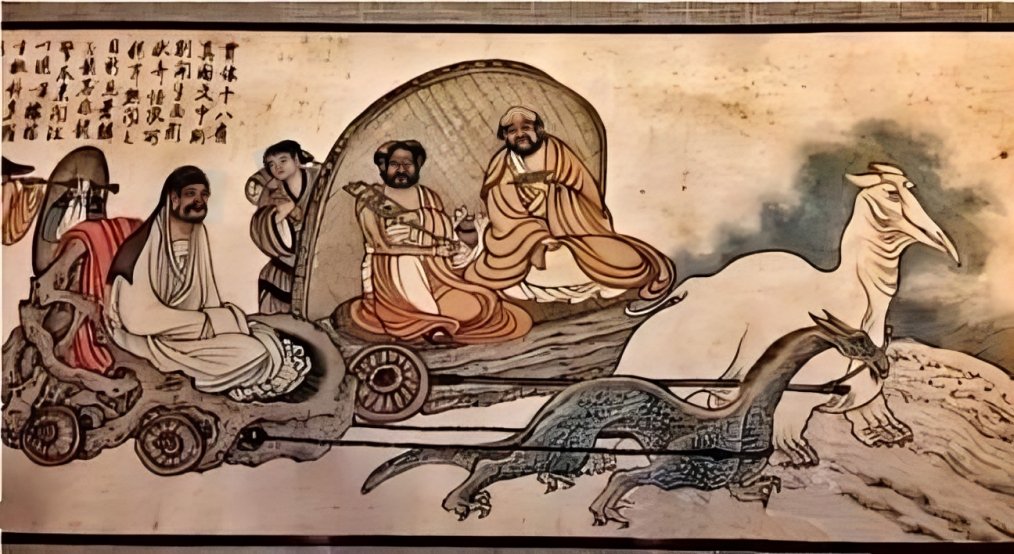
DINOSAURS AND MEN COEXIST
Dinosaurs and men lived at the same time. One of many pieces of evidence.
They were spared on the ark as juveniles or babies/eggs.
Most dinosaurs were not huge lumbering monsters to begin with. After the ark, the dinosaurs eventually went extinct due to a rapidly cooling climate and overhunting by man.
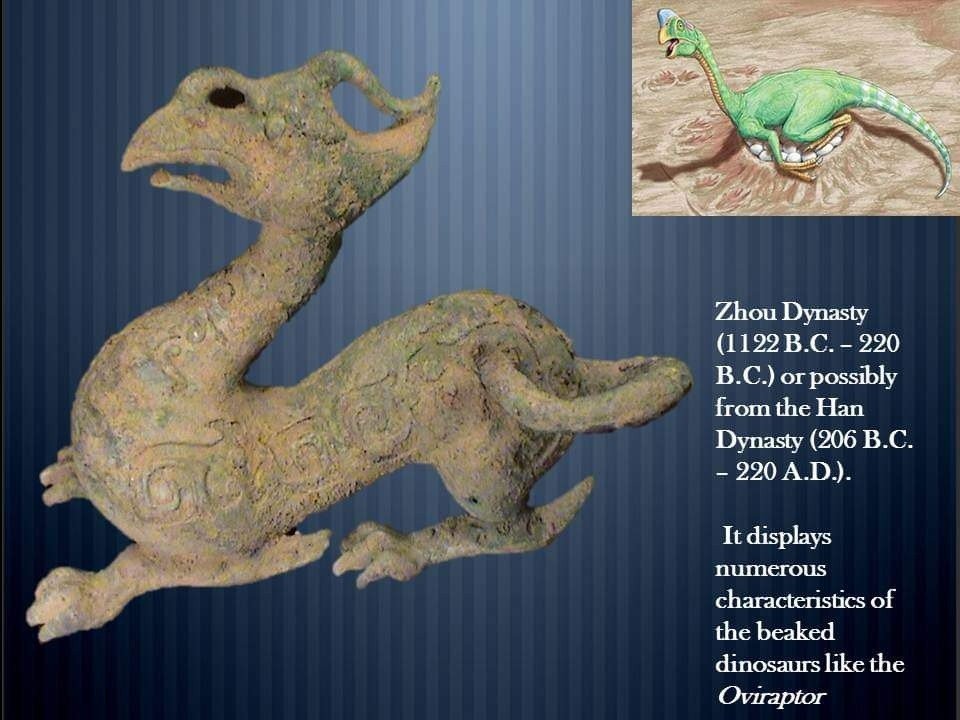
DINOSAUR HERD FOUND BURIED BY A FLOOD..NOAH'S FLOOD
In Mongolia 2001, a herd of 25 dinosaurs were found buried deep in sediment, of what had been thick mud. Evolutionists quickly employed the idea that a lake had existed there and the dinosaurs died there over a long period of time. However, the evidence left behind shows that the animals suffocated (death throw), and decomposed after being buried alive as a blue gray mass exists around each of where the animals were found. The limbs were bent as the animals struggled to get out of the mud. This is what we would expect to see as Bible believers who believe in Noah`s flood.
Most of the dinosaurs were buried in a life-like crouching posture and, even more surprisingly, the limbs of the dinosaurs were plunging down into the underlying mud as deep as 40 cm. Their hind legs were often still bent indicating that they were struggling to escape. Two of the skeletons were found one right over the other where they apparently fell. This fossil find captures in stone how the dinosaurs perished when they became mired in the mud.
The thick layer of mud in which the animals were trapped displayed bedding that was twisted and convoluted4 indicating that the sediment was only recently deposited from flowing water and still soft when it was disturbed. There was an absence of bioturbation (such as burrowing by worms or crustaceans) in the underlying mud,5 which also indicated that the mud was only recently deposited.
Not only was the thick under layer of sediment recently deposited, but the overlying sediments were deposited soon after the animals were trapped, burying the animals before their soft parts had a chance to rot away. Nearly all the fossil bones were surrounded by a drab, blue-gray halo indicating how far the soft tissue extended, and that the carcasses had decomposed after being buried, not before. In addition, gastroliths (stomach stones) were found in the fossilized ribcages of some animals, as well as carbonized stomach contents. So promptly were the animals buried that the delicate bones in the eye (sclerotic rings) of some animals were preserved. The team interpreted the site as a “catastrophic miring of an immature herd.
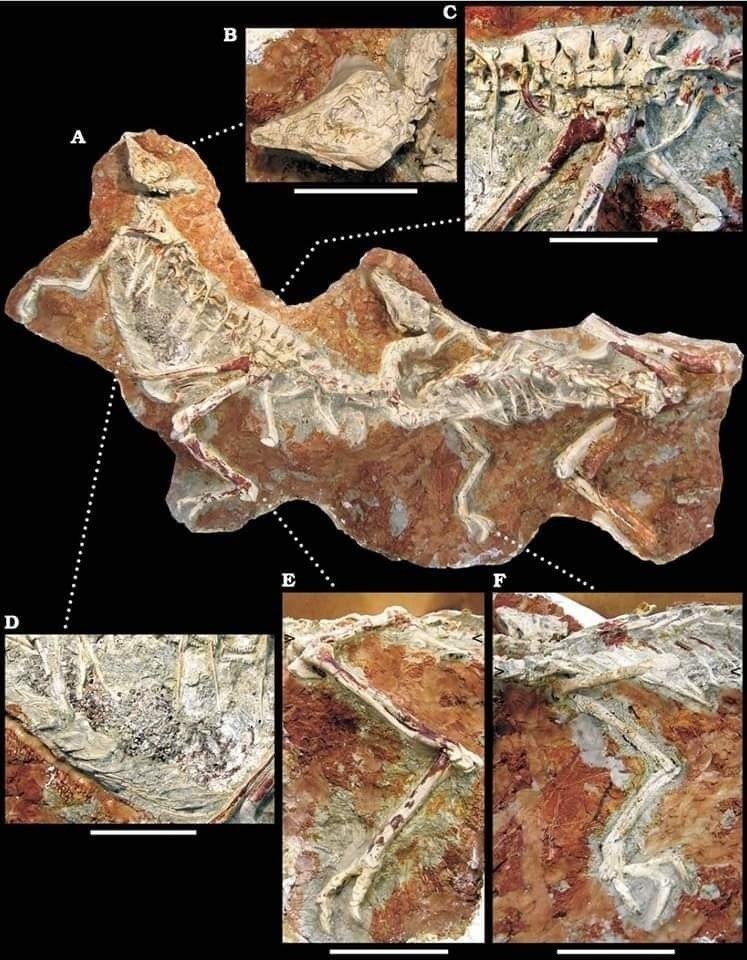
THE CLIFFS OF DOVER AND NOAH'S FLOOD
Located in England, these massive cliffs are composed of limestone (white chalk, calcium carbonite) which was created by the decayed remnants of tiny organisms.
Evolutionists claim that these cliffs which were once on the seabed below, were created over millions of years with very little sedimentation each year (.5 cm per year). But, according to the Biblical worldview, the right conditions during Noah`s flood caused the creation of these cliffs. These conditions include turbulent waters, high winds, decaying fish, and increased temperature and nutrients from volcanic waters and other sources. Many fossils have been found in the limestone, here and in other rich sources of limestone that point to a rapid burial of small and large organisms, which also cause serious doubt to the claim of millions of years of slow processes.

A "200 million year old" shark?
This is the bluntnose sixgill shark that evolutionists claim has existed since the Triassic, the early days of dinosaurs. Now we know those dates are nonsense, but the bluntnose sixgill shark exists today in 2024.
They try to make the claim this is a primitive shark, but there`s nothing primitive about it. It`s a fully formed variety of shark. The fact that it`s living today disproves millions of years of evolution. It was created along with all other fish in the sea during creation week.

SOLID PROOF OF MAN AND DINOSAUR CO-EXISTENCE..EVOLUTION NEVER HAPPENED!
This spectacular fossil footprint was found in July of 2000 by amateur archaeologist, Alvis Delk of Stephenville, Texas and is now on display at the Creation Evidence Museum, Glen Rose, TX. Mr. Delk found the loose slab against the bank of the Paluxy River, about one mile north of Dinosaur Valley State Park. He flipped over the rock and saw an excellent dinosaur track, so he took it home where it sat in his living room for years, with hundreds of other fossils.
Early in 2008 he had a devastating accident. He fell off of a roof incurring damage that required months of hospitalization. He still has a dangerous blood clot in his brain.
When he returned to his home, he decided he would sell the dinosaur track, thinking Dr. Carl Baugh of the nearby Creation Evidence Museum would pay a few hundred dollars for it. He began to clean the rock, and that was when he discovered the fossil human footprint underneath the dried clay!
<
The human footprint had been made first, and shortly thereafter (before the mud turned to stone), a dinosaur stepped in the mud with its middle toe stepping on top of the human track. You can actually see the displaced mud from the dinosaur`s middle toe inside the human footprint.
Spiral CT scans are used to generate images of the inside of an object from a large series of two-dimensional X-ray images taken around a single axis of rotation. This technology provides an effective means of analyzing fossil footprints without physically destroying them. It allows us to see inside the rock, specifically, under the footprint.

THE IPUWER PAPYRUS, EVIDENCE OF THE EXODUS PLAGUES
In the early 19th Century an ancient papyrus was found in Egypt. It was taken to the Leiden Museum in Holland and interpreted by A.H. Gardiner in 1909. The papyrus describes violent upheavals in Egypt, starvation, drought, escape of slaves (with the wealth of the Egyptians), and death throughout the land. The papyrus was written by an Egyptian named Ipuwer and appears to be an eyewitness account of the effects of the Exodus plagues. The account parallels the Book of Exodus. Read the comparison to scripture down below.
- Papyrus 2:10 - The river is blood.
- Exodus 7:20 - ...all the waters that were in the river were turned to blood.
- Papyrus 4:14, 6:1 - Trees are destroyed. No fruit nor herbs are found.
- Exodus 9:25 - ...and the hail smote every herb of the field, and brake every tree of the field.
- Papyrus 2:10 - Forsooth, gates, columns and walls are consumed by fire.
- Exodus 9:23-24 - ...the fire ran along the ground.... there was hail, and fire mingled with the hail, very grievous.
- Papyrus 9:11 - The land is not light....
- Exodus 10:22 - ...and there was a thick darkness in all the land of Egypt.
- Papyrus 4:3, 5:6, 6:12 - Forsooth, the children of princes are dashed against the walls. Forsooth, the children of princes are cast out in the streets.
- Exodus 12:29 - And it came to pass, that at midnight the Lord smote all the firstborn in the land of Egypt, from the firstborn of Pharaoh that sat on his throne unto the firstborn of the captive that was in the dungeon.
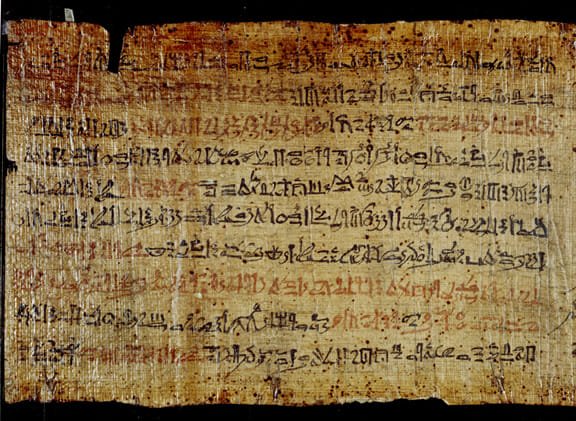
ANCIENT CHINESE LANGUAGE PROVES THE BIBLE
Ancient Chinese pictographs are silent witnesses, like fingerprints, of historical events reported in Genesis. In particular, the details of these word-symbols are clues that point to how the earliest Chinese must have known basic facts of Genesis 1–11 at the very time their pictographs were invented. Chinese is not an alphabet-based language—its word characters are both abbreviations of and combinations of picture symbols. The simplest symbols are combined to construct composite symbols that denote compound words. However, the actual pictures that were chosen, and especially their associated meanings, are what give us an amazing insight into Chinese history.
The pictographic clues to that mysterious past have remained hidden in plain view for thousands of years. Since Chinese civilization began soon after the Tower of Babel fiasco, the first Chinese settlers still had a fresh memory of mankind`s origins—from creation week to the dispersion of languages at Babel. Thus, they not only knew the history highlights in Genesis 1–11, but they would also have regarded those same events as important in human history and experience. It is unsurprising, therefore, that many of the picture-symbol characters, in the ancient Chinese language, match the thinking of a soon-after-Babel people who retained important memories of historic events reported in Genesis 1–11.

BIBLE PROOFS
The name inscribed in hieroglyphs on this artifact is "Haaibra," the throne name of Pharaoh Hophra (Apries) who is referred to in the Bible in Jeremiah 44:30. The sandstone block was purchased in Cairo in 1919, and is now on display in the Oriental Institute Museum at the University of Chicago
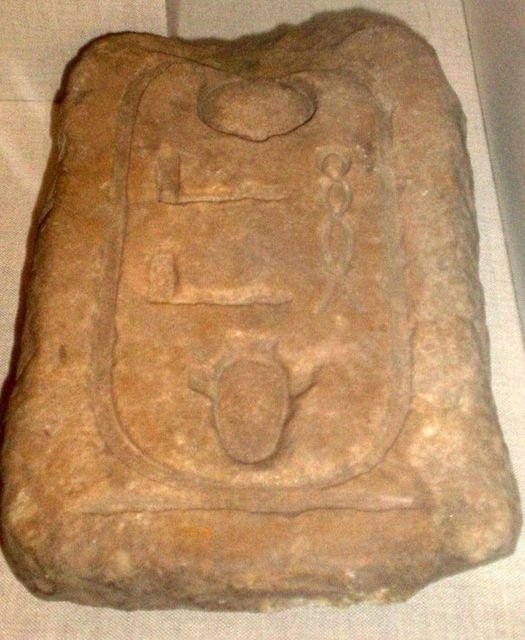
Red Sea Chariots
Believe it or not, chariot wheels and bones have been found under the Red Sea. Just more proof that the Bible is Truth. Watch Patterns of Evidence for great proof of the Exodus account and see the comments for proof that backs up the photo.
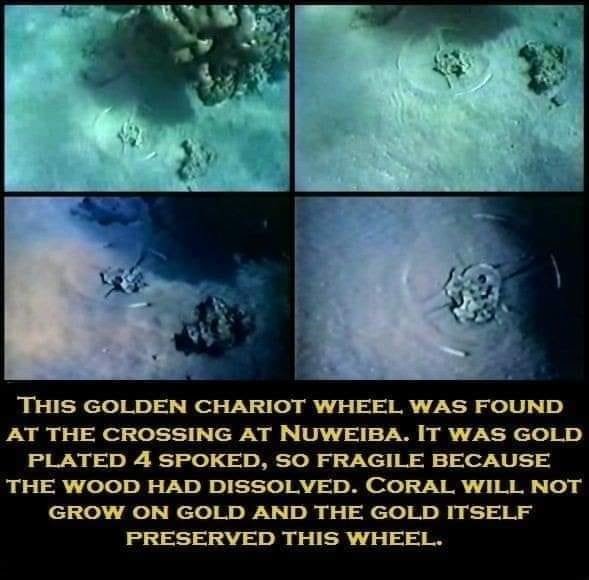
RADIOMETRIC DATING HAS SERIOUS ISSUES
HOW CAN EVOLUTIONISTS CLAIM MILLIONS OF YEARS WITH UNRELIABLE DATING METHODS?
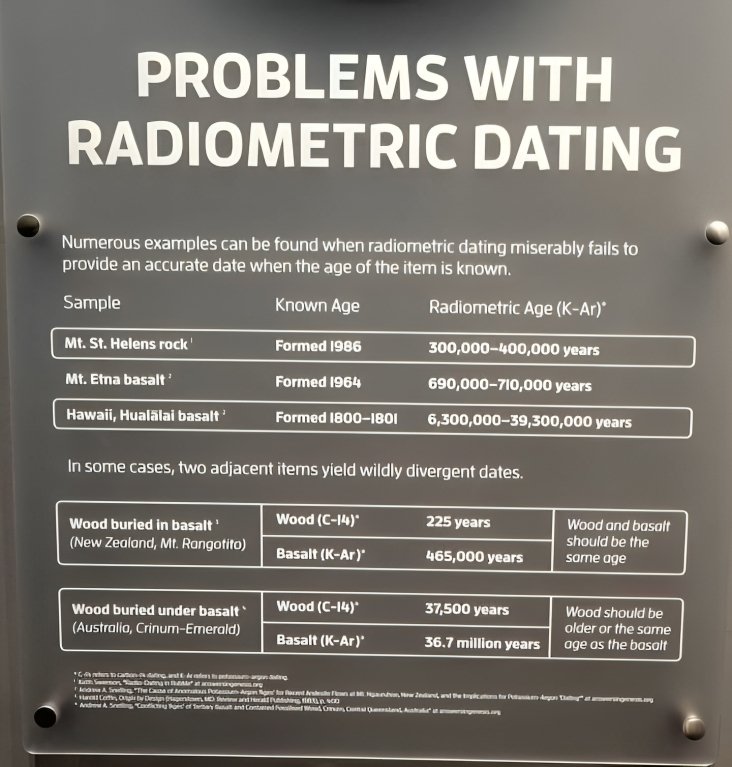
FLOOD LEGENDS
The Toltec Indians of Ancient Mexico have recorded that their history lasted 1,716 years and was destroyed by a great flood. A few men escaped the flood in a closed chest. Following the great flood, men began to multiply and built a very high tower. However, their language became confused, so different language groups wandered to other parts of the world. The Toltecs claim they started as a family of 7 friends and their wives who spoke the same language. They crossed great water, lived in caves, and wandered 104 years until they came to southern Mexico. The account reports that this took place 520 years after the great flood.
Coincidence? I think not. While a few small details are not exact, they match up greatly with the Biblical record. Almost every ancient culture has a record of a great flood in the past. This is a fact.
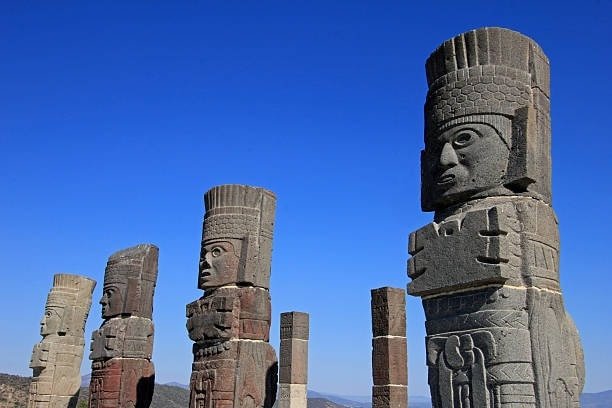
Dinosaur Mummy
This dinosaur mummy was discovered in Northern Alberta, and scientists say it was covered with water when it died. This creature still has its skin and internal organs intact (still fossilized). Now tell me folks, how can this animal be 110 million years old as evolutionists claim? Evolution and millions of years are man made theories that fall flat.
This is another victim of the Biblical worldwide flood. Preserved by water and sediment.
There are many other dinosaur mummies, some that even have stomach contents preserved. It takes special preservation to do this QUICKLY without decomposition and scavenging by other animals.
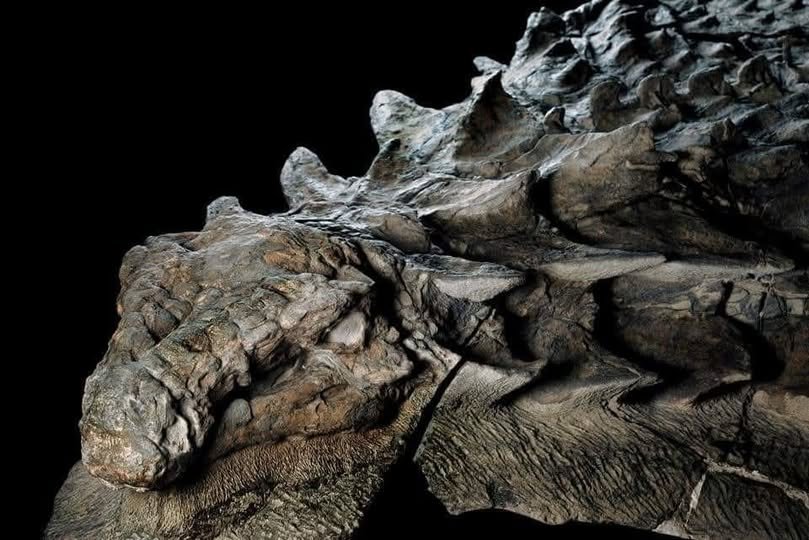
Complexity of The Human Body
The odds of a functioning organism developing:
- The chance of a 200-component organism developing by mutation and natural selection is less than one in a billion trillion
The odds of forming a basic cell:
- The probability of a basic cell forming by natural processes is at best one in 1040,000. This number assumes that all the necessary ingredients are present, which is impossible
The odds of obtaining all enzymes:
- The chance of obtaining all two thousand enzymes in a random trial is one in 1040,000,2000
The odds of a meaningful system forming:
- The odds of randomly assembling ten components into a meaningful system are at least 36,000 to one
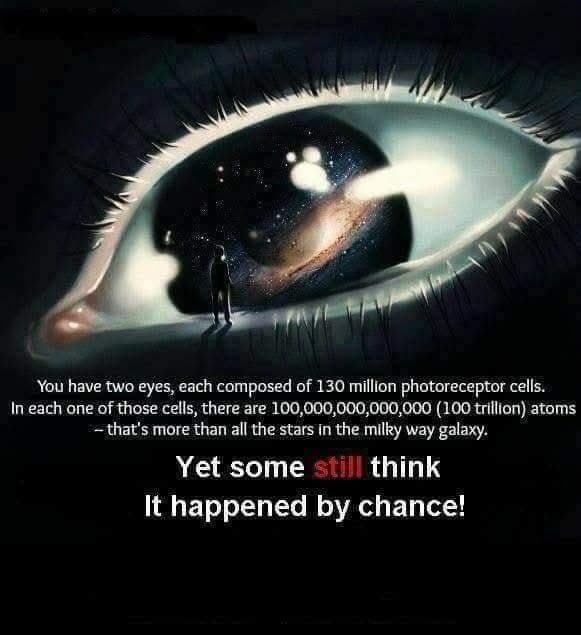
THE MOON IS EVIDENCE OF A YOUNG CREATED EARTH
The moon is moving away from Earth about two inches a year. The moon moving away from the Earth little by little is called lunar recession. If the Earth is 6,000 years old, and lunar recession has always been happening, the moon has moved 1,000 feet away from the Earth since creation.
But evolutionists teach that the moon is 4 billion years old. Working back 2 inches a year, the moon would have been causing impossibly high tides and related problems within only 10% that much time. In less than 50% of the assumed age of the moon, it would have been touching the Earth`s surface. Evolutionists have a big problem with the age of the moon. It simply can`t be billions of years old. The moon`s recession is evidence that the Earth and moon were both created in the Biblical time frame of 6,000 years.

EXODUS
Papyrus Brooklyn 35.1446 is a seven foot long papyrus from the 12th or 13th Dynasty era of the Middle Kingdom period in Egypt, in the late 19th or 18th century BC. The papyrus is written in the ancient Egyptian language in hieratic script.
The text discusses a woman by the name of Senebtisi and her efforts to secure ownership of 95 servants. It also relays that a number of servants failed to complete their assigned tasks and it gives instructions for how to handle them.
Most of the servants are female, and they are assigned to a variety of roles including hairdresser, fieldhand, gardener, cook, brewer, and weaver. Roughly half of the servants are identified as being ‘Asian,’ likely from the Levant, the area of Syria and Canaan. The Asiatics are listed with their original name and they are also given an Egyptian name.
Roughly a third of the total number of servants have identifiable Semitic names, Semitic being the language family to which Hebrew belongs. The names listed include: Baaltuya, Aduna, Isibtu, Shamashtu, Ayyabum, Dawidi-huat, and Esebtw. Some of the names can be readily identified as being female forms of known Hebrew names: Menahema, Ashera, and Aqaba, which is comparable to Ya’aqob.
I suggest taking a look at the Patterns of Evidence film, and Decoding the Exodus by James Cameron (The Titanic director). They prove the Exodus occured in great detail. Some scholars refuse certain pieces of evidence because they are using an outdated chronology. They bring everything to light.
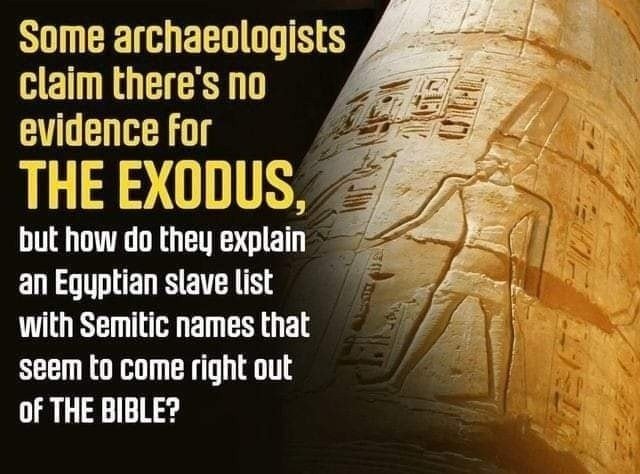
BIBLICAL PTEROSAURS
Where do pterosaurs "winged lizards" (or flying reptiles) fit into history? Evolutionists say these flying reptiles and man did not live together. Yet, according to the Bible, pterosaurs must have been created on day 5, while man was created on day 6. When the flood came, Noah must have taken some of these creatures along with every other created kind of land dwelling creature aboard the ark.
Many cultures around the world speak of pterosaurs, but they use different names. In Isaiah 14:29 and 30:6, it mentions "fiery serpents." Maybe you have heard of the thunderbird "legend". It was a large creature with a bony crest, sharp claws on its wings, and a long, sharp beak. When it flew, its wings thundered. It was a fearful creature to those who described it. The thunderbird stories appear in Native American cultures from Alaska to South America.
Ancient Native American artwork also depicts these flying creatures. One of the verified Ica Burial stones of Peru displays a carving of a pterosaur. In one of Utah`s canyons, along with other Native pictographs, a flying creature with a crest on its head looking very much like a pterosaur is portrayed. Herodetus (460 BC) wrote of flying reptiles in ancient Egypt and Arabia. Even today, there are reports of flying creatures that resemble pterosaurs in Papa New Guinea and the deepest jungles in Africa.
Evolutionists need to try and explain this all away in order to maintain the belief that man and dinosaurs were separated by millions of years of make-believe evolution. It is simply a story designed to deny the Bible and deny God. Very clearly, man and flying reptiles (dinosaurs too) did live together. The Bible does not lie.
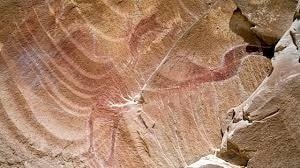
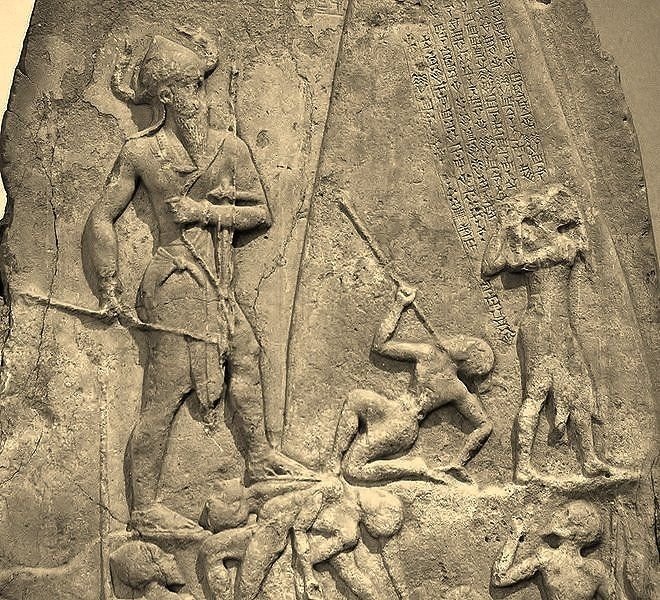

















.jpg)


















